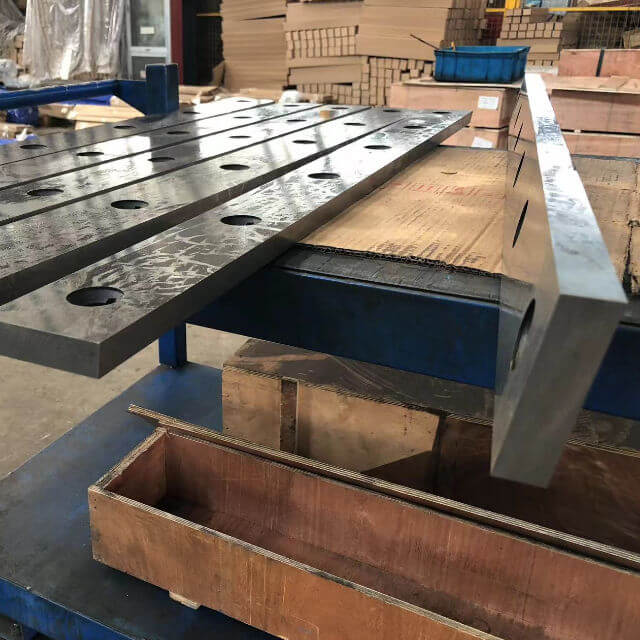Everything You Need to Know About Shear Blades
Shear blades are critical cutting tools in industrial machinery, designed to slice through metal, plastic, textiles, and other materials with precision and efficiency. From sheet metal fabrication to recycling scrap, shear blades play a pivotal role in manufacturing processes. This guide explores their types, materials, design considerations, maintenance, and emerging trends.
1. Types of Shear Blades
Shear blades are categorized by their cutting mechanism, application, and material compatibility.
A. By Cutting Mechanism
• Guillotine Shear Blades:
• Structure: Fixed lower blade and movable upper blade (straight or inclined).
• Applications: Cutting flat sheets (steel, aluminum) into precise lengths.
• Advantages: High-speed, high-volume production; minimal material distortion.
• Rotary Shear Blades:
• Structure: Circular or disc-shaped paired blades rotating in opposite directions.
• Applications: Slitting coils, cutting tubes, or processing continuous materials (e.g., paper, foil).
• Advantages: Continuous cutting, low noise, and high repeatability.
• Punching/Notching Shear Blades:
• Structure: Specialized blades for creating holes, slots, or notches.
• Applications: HVAC ductwork, automotive parts, and architectural metalwork.
B. By Application
• Metalworking Shear Blades:
• Designed for high-tensile steel, stainless steel, or alloy sheets.
• Require hardness (HRC 58–62) and wear resistance.
• Scrap Shear Blades:
• Heavy-duty blades for cutting irregular scrap (e.g., car bodies, pipes).
• Built with thicker profiles and impact-resistant alloys.
• Textile/Plastic Shear Blades:
• Sharper edges and lower hardness (HRC 45–55) to prevent material tearing.
2. Materials and Manufacturing
The durability and cutting performance of shear blades depend on material selection and heat treatment.
A. Common Materials
• D2 Tool Steel:
• High carbon and chromium content (1.5% C, 12% Cr).
• Ideal for general-purpose metal cutting; affordable but prone to chipping.
• H13 Hot Work Steel:
• Toughness at elevated temperatures (up to 540°C).
• Used in high-speed rotary shears or hot-cutting applications.
• Tungsten Carbide (WC):
• Extreme hardness (HRC 85–92) and wear resistance.
• Costly but ideal for abrasive materials (e.g., titanium, composites).
• Cermet and Ceramic Coatings:
• Applied via PVD/CVD for enhanced edge retention and corrosion resistance.
B. Heat Treatment and Coatings
• Quenching and Tempering: Achieves optimal hardness-toughness balance.
• Nitriding: Creates a hard surface layer (0.1–0.5 mm) without reducing core toughness.
• Titanium Nitride (TiN) Coatings: Reduces friction and extends blade life by 3–5x.
3. Design Considerations
Proper blade geometry and alignment are critical for clean cuts and tool longevity.
A. Blade Geometry
• Clearance Angle: Typically 1–5% of material thickness to prevent edge rolling.
• Rake Angle: Positive angles (5–15°) reduce cutting forces but may dull faster.
• Edge Profile:
• Straight Edge: For guillotine shears; produces clean 90° cuts.
• Serrated Edge: Improves grip on soft/slippery materials (e.g., plastics, rubber).
B. Alignment and Fit
• Parallelism: Blades must be parallel within ±0.02 mm to avoid uneven wear.
• Overlap: Proper overlap (0.5–2 mm) ensures full material penetration without edge collision.
• Backlash: Minimal clearance between blades prevents material jamming.
4. Maintenance and Lifespan Extension
Regular care maximizes blade efficiency and reduces downtime.
A. Daily Checks
• Inspect edges for nicks, cracks, or dulling.
• Verify blade alignment and parallelism.
• Clean debris from blade surfaces and hydraulic systems.
B. Sharpening and Reconditioning
• Grinding: Use CNC-controlled grinders for consistent edge geometry.
• Re-profiling: Restore original angles and clearances after repeated sharpening.
• Limit Sharpening Cycles: Typically 3–5 regrinds before replacement (depending on material).
C. Storage and Handling
• Coat blades in rust inhibitor when stored.
• Avoid dropping or impacting blades to prevent microcracks.
5. Emerging Trends and Innovations
The industry is evolving toward smarter, more sustainable solutions.
• Smart Shear Blades:
• Embedded sensors monitor blade wear, temperature, and cutting forces.
• Predictive maintenance algorithms alert operators to replacement needs.
• 3D-Printed Blades:
• Complex cooling channels and optimized geometries for reduced heat buildup.
• Eco-Friendly Materials:
• Recyclable steel alloys and biodegradable coatings to minimize environmental impact.
• Automation Integration:
• Robotic blade changing systems for 24/7 uninterrupted operation.
Conclusion
Shear blades are the unsung heroes of industrial cutting, combining precision engineering with material science. Selecting the right blade type, material, and maintenance protocol ensures cost-effective, high-quality output. As industries embrace Industry 4.0, shear blades will continue to evolve, offering smarter, more sustainable solutions for tomorrow’s manufacturing challenges.


